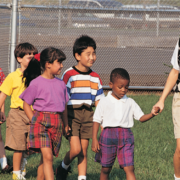Road Safety For Kids
Teach your child to be a safe pedestrian.
It’s never too early to teach your child to be street smart. All it takes is a little time—time to prepare, plan and teach your child how to be safe on the road.
Make learning fun for young children
Practice makes perfect. For young children, learning should be fun and interactive. Here are some ideas to help your child develop safe habits:
- Map it out. Plan your child’s walking route, review street names and landmarks while walking together.
Quiz your child on traffic signs whenever using marked crosswalks, crossing lights and intersections.
Create a game to encourage your child to follow your footsteps.
Set a good example
Get back to the basics with these simple safety tips.
- Look left-right-left and shoulder check before crossing.
- Make eye contact with drivers and keep looking for approaching vehicles while crossing.
Listen. - Remove your headphones so you can hear approaching traffic that may be hard to see.
- Be seen.
- Wear reflective materials or bright clothes and use lights after dark.
- Walk on the inside edge of the sidewalk away from the road. If there’s no sidewalk – walk facing oncoming traffic, so you can see approaching vehicles.
- Never jaywalk.
Be a good role model for your child when you’re driving in school and playground areas.
Watch your speed. A 30km/h speed limit is in effect in school zones from 8 a.m. to 5 p.m. when school’s in session and in playground areas from dusk until dark, unless otherwise posted.
Be patient. Drop off your child close to the sidewalk. Don’t let them dash from the middle of the road.
Know the law. Always yield to pedestrians and stop for school buses when their lights are flashing.
source: http://www.icbc.com/road-safety/teaching/Pages/road-safety-for-your-kids.aspx



